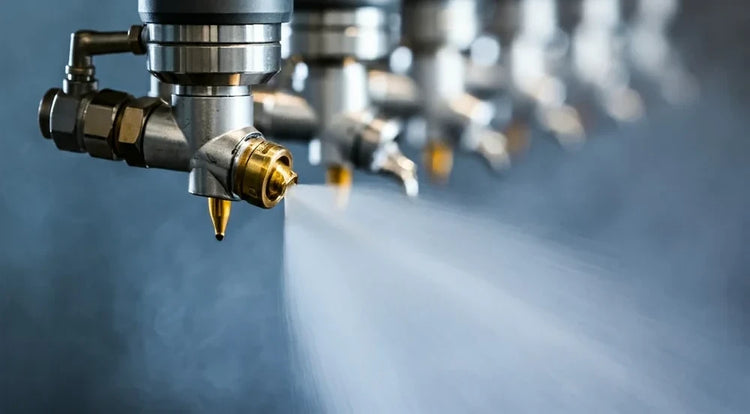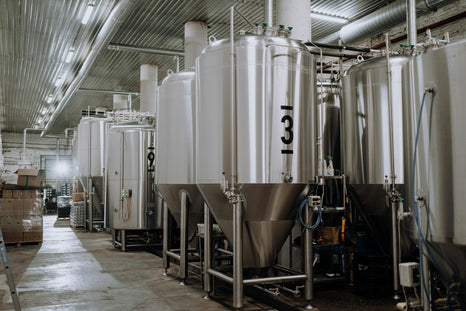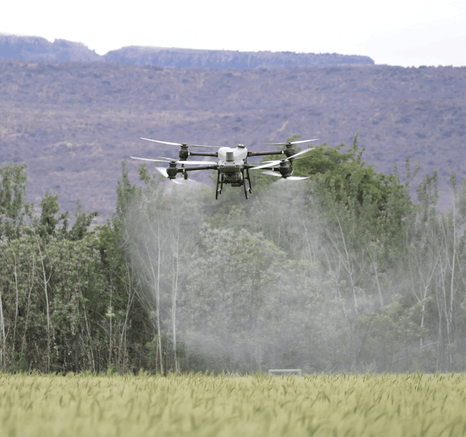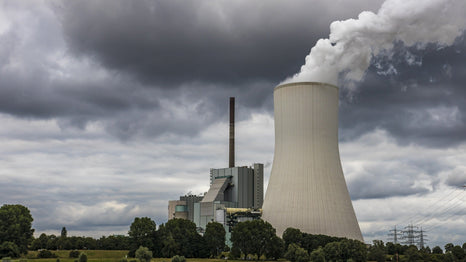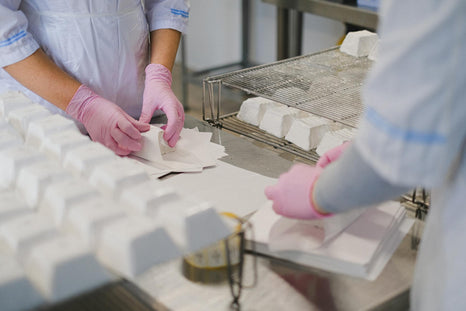Air atomizing nozzles mix liquids with compressed air to create a fine mist. This technology is great for many uses like coating, cooling, and humidifying. By understanding how these nozzles work and where they can be applied, you can make smart choices to improve performance and efficiency in various tasks.
Key Takeaways
- Air atomizing nozzles produce fine droplets by mixing liquid with compressed air.
- These nozzles are useful for coating, humidifying, gas cooling, and fogging.
- Different designs, like fan and cone spray patterns, offer various application options.
- Choosing the right nozzle involves evaluating application needs and control features.
- Regular maintenance and troubleshooting ensure optimal performance.
Principles of Air Atomizing Nozzles
Internal Mixing Mechanism
Air atomizing nozzles work by combining liquid and compressed air at low pressures to create fine droplets. In internal mixing, the liquid and air mix inside the nozzle before being expelled. This method is ideal for applications requiring a consistent and fine spray pattern.
External Mixing Mechanism
In external mixing, the liquid and air mix outside the nozzle. This allows for greater control over the spray pattern and droplet size. External mixing is often used when different spray characteristics are needed for various applications.
Shear and Rupture Dynamics
The process of atomization involves shear and rupture dynamics. The compressed air shears the liquid into tiny droplets, creating a fine mist. This mechanism is crucial for achieving the desired spray quality and efficiency in industrial applications.
Understanding the principles of air atomizing nozzles is essential for optimizing their performance in various industrial settings.
Applications of Air Atomizing Nozzles
Coating and Humidifying
Air atomizing nozzles are widely used for coating and humidifying applications. They produce very fine droplets, which ensure even coverage and efficient moisture control. This makes them ideal for processes like painting, where a smooth, uniform coat is essential, and for maintaining humidity levels in controlled environments.
Gas Cooling and Conditioning
In industrial settings, air atomizing nozzles are employed for gas cooling and conditioning. By creating a fine mist, these nozzles effectively reduce the temperature of gases and help in conditioning them for further processing. This application is crucial in industries where gas temperature control is vital for safety and efficiency.
Lubricating and Fogging
Air atomizing nozzles are also used for lubricating machinery and fogging applications. The fine mist generated by these nozzles ensures that lubrication is evenly distributed, reducing wear and tear on moving parts. In fogging applications, the nozzles help in creating a mist that can be used for cooling, dust suppression, or creating special effects in various settings.
The versatility of air atomizing nozzles makes them indispensable in many industrial processes, from coating and humidifying to gas cooling and lubricating.
Design and Configuration Options
Fan and Cone Spray Patterns
Air atomizing nozzles come in various spray patterns, with fan and cone being the most common. Fan spray patterns are ideal for covering wide areas, while cone spray patterns are better for targeted applications. The choice between these patterns depends on the specific requirements of the task at hand.
Pressure- and Gravity-Fed Setups
There are two main types of setups for air atomizing nozzles: pressure-fed and gravity-fed. Pressure-fed setups use a pump to deliver fluid to the nozzle, providing consistent spray performance. Gravity-fed setups rely on gravity to feed the fluid, which can be simpler and more cost-effective but may not offer the same level of control.
Material and Durability Considerations
The materials used in the construction of air atomizing nozzles are crucial for their durability and performance. Common materials include stainless steel, brass, and plastic. Each material has its own advantages and limitations, so it's important to choose the right one based on the application's demands.
Selecting the appropriate design and configuration for your air atomizing nozzle can significantly impact its performance and longevity. Careful consideration of spray patterns, feeding setups, and materials will ensure optimal results.
Advantages of Using Air Atomizing Nozzles
Fine Droplet Production
Air atomizing nozzles are known for their ability to produce very fine droplets. This is particularly useful in applications where uniform droplet size and distribution are crucial, such as in gas cooling and pollution control. The fine atomization ensures superior coverage and efficiency.
High Accuracy and Consistency
These nozzles offer high accuracy and consistency in droplet size, making them ideal for processes that require precise control. This level of control is often not achievable with single-fluid nozzles, especially when dealing with viscous fluids.
Cost Efficiency and Performance
While the use of compressed air can add to operational costs, the efficiency and performance gains often outweigh these expenses. When the right nozzle is used, it can significantly improve the production process, making it more cost-effective in the long run.
The right air atomizing nozzle can lead to better performance and lower costs, making it a valuable investment for various industrial applications.
Choosing the Right Air Atomizing Nozzle
Selecting the appropriate air atomizing nozzle is crucial for achieving optimal performance in various industrial applications. Evaluating your specific application requirements is the first step in this process. Consider factors such as the type of fluid, desired spray pattern, and operating conditions.
Evaluating Application Requirements
When choosing a nozzle, it's essential to understand the specific needs of your application. For instance, if you need a fine mist for cooling, a nozzle with a narrow angle round pattern might be ideal. On the other hand, for coating applications, a fan spray pattern could be more suitable.
Adjustability and Control Features
Modern air atomizing nozzles come with various adjustability and control features. These include independent control of liquid, atomizing air, and fan air pressure, allowing for fine-tuning of flow rate, drop size, spray distribution, and coverage. Options like clean-out and shut-off needles further enhance the nozzle's functionality.
Common Mistakes and Solutions
One common mistake is not matching the nozzle type to the specific application, leading to suboptimal performance. Another is neglecting regular maintenance, which can result in clogging and reduced efficiency. To avoid these issues, always refer to the manufacturer's guidelines and perform routine checks. If you encounter persistent problems, consulting with experts or referring to troubleshooting guides can provide effective solutions.
Choosing the right air atomizing nozzle can significantly impact your operational efficiency and product quality. Always consider your specific needs and consult with experts if necessary.
Innovations in Air Atomizing Nozzle Technology
No Drip Feature
One of the latest advancements in air atomizing nozzle technology is the no drip feature. This innovation prevents unwanted drips when the nozzle is not in use, ensuring a clean and efficient operation. It is particularly useful in applications where precision and cleanliness are paramount, such as in coating and humidifying processes.
Variable Air Control
Variable air control allows for independent adjustment of liquid, atomizing air, and fan air pressure. This feature provides fine-tuning capabilities for flow rate, drop size, spray distribution, and coverage. NozzlePro offers a range of variable air atomizing nozzles that include options like clean-out and shut-off needles, enhancing the versatility and performance of the nozzles.
Advanced Material Use
The use of advanced materials in the construction of air atomizing nozzles has significantly improved their durability and performance. Materials such as stainless steel and specialized alloys are commonly used to withstand harsh industrial environments. This ensures that NozzlePro's nozzles maintain their efficiency and longevity, even under demanding conditions.
The integration of these innovations in air atomizing nozzles not only enhances their performance but also extends their lifespan, making them a cost-effective solution for various industrial applications.
Maintenance and Troubleshooting
Common Issues and Fixes
Air atomizing nozzles can face several common issues that may affect their performance. Clogging is one of the most frequent problems and can be caused by debris or impurities in the fluid. To fix this, regularly inspect and clean the nozzles. Another issue is uneven spray patterns, which can result from wear and tear or incorrect pressure settings. Adjusting the pressure and replacing worn parts can resolve this.
Cleaning and Upkeep
Proper cleaning and upkeep are essential for maintaining the efficiency of air atomizing nozzles. Follow these steps for routine maintenance:
- Disconnect the nozzle from the system.
- Soak the nozzle in a cleaning solution to dissolve any buildup.
- Use a soft brush to gently scrub away any remaining debris.
- Rinse thoroughly with clean water.
- Reassemble and reconnect the nozzle.
Regular maintenance not only ensures optimal performance but also extends the lifespan of the nozzles.
Consistent maintenance can prevent many common issues and ensure reliable operation.
Performance Monitoring
Monitoring the performance of air atomizing nozzles is crucial for early detection of potential problems. Keep an eye on spray patterns, droplet size, and flow rates. Any deviations from the norm can indicate underlying issues that need attention. Implementing a regular inspection schedule can help in identifying and addressing problems before they escalate.
Keeping your spray nozzles in top shape is key to their performance. Regular maintenance can prevent many common issues. If you run into trouble, don't worry! Our website has a ton of resources to help you out. Visit us today and keep your equipment running smoothly.
Conclusion
Air atomizing nozzles offer a versatile and efficient solution for a variety of industrial applications. By combining liquid and compressed air, these nozzles produce fine droplets that are ideal for tasks such as coating, cooling, and humidifying. Despite the additional cost of compressed air, the benefits of improved precision and efficiency often outweigh the expenses. Selecting the right nozzle for the job is crucial to maximizing performance and minimizing costs. As technology advances, air atomizing nozzles continue to evolve, providing even more options and capabilities for industrial processes. In summary, the use of air atomizing nozzles can significantly enhance performance and productivity in various settings.

